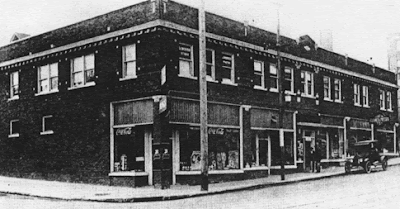 "Greetings viewers and welcome to "Theoryland," the thinkingest place of them all!"
"Greetings viewers and welcome to "Theoryland," the thinkingest place of them all!" "Every week we'll take you to one of several exciting lands. This week come with us to 'Fromteerland,' where young people can relive the thrilling days of yesterday when our pioneer ancestors hunted down polecats like predatory animation writers."
"Every week we'll take you to one of several exciting lands. This week come with us to 'Fromteerland,' where young people can relive the thrilling days of yesterday when our pioneer ancestors hunted down polecats like predatory animation writers."
"Here to tell you more about it is our host, Uncle Eddie..."
 "Hello folks and welcome to the show. Here at Theory Corner we always strive to top ourselves and 'Theoryland' is our latest effort. We've chosen to begin the show here in Fromteerland but I thought you might like to get an overview of the whole series. Follow me and I'll see what I can do."
"Hello folks and welcome to the show. Here at Theory Corner we always strive to top ourselves and 'Theoryland' is our latest effort. We've chosen to begin the show here in Fromteerland but I thought you might like to get an overview of the whole series. Follow me and I'll see what I can do."
 "Of course the cornerstone of our show is good, solid family entertainment...art, history and science combined, something for the mind as well as the eye. Here for example is an organ derived from a male T-Rex. What organ we don't know but our staff is consulting with paleontologists about it right now and when we find out we'll do a show about it."
"Of course the cornerstone of our show is good, solid family entertainment...art, history and science combined, something for the mind as well as the eye. Here for example is an organ derived from a male T-Rex. What organ we don't know but our staff is consulting with paleontologists about it right now and when we find out we'll do a show about it."
 "Occasionally we'll have visits from Theoryland regulars like Darnold Mallard. Here you see the reaction of Darnold's doctor when he discovers a human face in Darnold's throat. Click to enlarge."
"Occasionally we'll have visits from Theoryland regulars like Darnold Mallard. Here you see the reaction of Darnold's doctor when he discovers a human face in Darnold's throat. Click to enlarge."
 "Hello folks and welcome to the show. Here at Theory Corner we always strive to top ourselves and 'Theoryland' is our latest effort. We've chosen to begin the show here in Fromteerland but I thought you might like to get an overview of the whole series. Follow me and I'll see what I can do."
"Hello folks and welcome to the show. Here at Theory Corner we always strive to top ourselves and 'Theoryland' is our latest effort. We've chosen to begin the show here in Fromteerland but I thought you might like to get an overview of the whole series. Follow me and I'll see what I can do." "Of course the cornerstone of our show is good, solid family entertainment...art, history and science combined, something for the mind as well as the eye. Here for example is an organ derived from a male T-Rex. What organ we don't know but our staff is consulting with paleontologists about it right now and when we find out we'll do a show about it."
"Of course the cornerstone of our show is good, solid family entertainment...art, history and science combined, something for the mind as well as the eye. Here for example is an organ derived from a male T-Rex. What organ we don't know but our staff is consulting with paleontologists about it right now and when we find out we'll do a show about it." "Occasionally we'll have visits from Theoryland regulars like Darnold Mallard. Here you see the reaction of Darnold's doctor when he discovers a human face in Darnold's throat. Click to enlarge."
"Occasionally we'll have visits from Theoryland regulars like Darnold Mallard. Here you see the reaction of Darnold's doctor when he discovers a human face in Darnold's throat. Click to enlarge."

 "Well here's my transportation now! It looks like that's all we have time for this week!"
"Well here's my transportation now! It looks like that's all we have time for this week!"





























